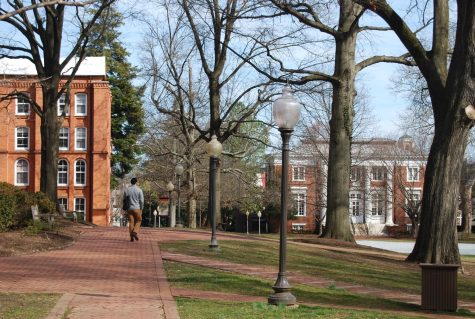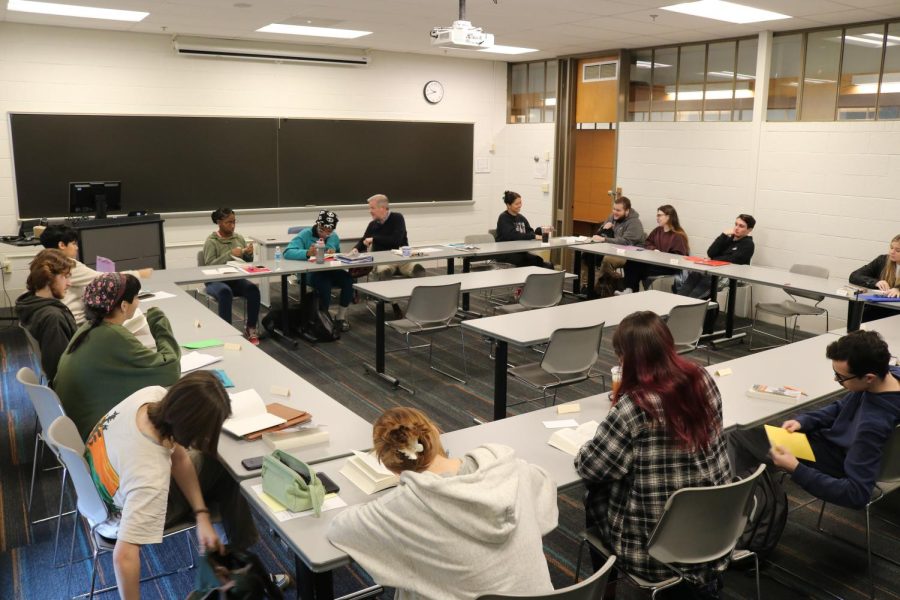Students lead class discussions in seminar-style courses
English professor Steve Canaday, center, teaches seminar-style classes through the BLAST program.
April 6, 2023
Approximately a dozen AACC professors have converted their humanities courses into seminars that focus on class discussions rather than lectures.
Faculty from St. John’s College in Annapolis instructed AACC professors over the last three summers on how to teach seminar-style classes.
Seminar-style classes, said English professor Candice Hill, “re-emphasize … the value of community within classrooms. And if a community college isn’t valuing community, the classroom itself or the community outside, I don’t think it’s really doing its job.”
Through the program, called BLAST, or Bridge to the Liberal Arts through Primary-Source Texts, professors learned how to adjust their existing humanities courses—like English, philosophy, history, music appreciation, art history and anthropology—into discussion-based learning.
“The idea behind seminar is really simple,” English professor Steve Canaday, who is teaching all of his courses as seminars this semester, said. “And the idea is that you learn better when you figure stuff out for yourself in a group of other people who are trying to figure stuff out for themselves. … When I’m teaching the seminar, I try to keep my mouth shut, which is hard for me to do. And the students who’ve all read the same text discuss the text. We’re all equals; that’s the idea in seminar. I’m not trying to lead them anywhere.”
AACC and St. John’s partnered to apply for a $100,000 grant from the National Endowment for the Humanities to fund the training. The grant expired in January, but professors said they will continue teaching seminars.
Dean of the School of Liberal Arts Alicia Morse said the program is “absolutely moving into the future.”
“In fact, we offer more [BLAST classes] now than we had” last semester, Canaday said.
First-year computer science student Gaelle Milfort said BLAST classes are “amazing.”
“It’s very insightful; it’s very proactive and I think it’s a great way to understand the material and the book we’re reading,” Milfort said. “I look forward to coming to this class.”
St. John’s graduate student Siobhan Petersen, who attended AACC from 2013-16, sat in on one of Canaday’s classes.
“They had just started [learning] the ‘Tao Te Ching,’” Petersen, who attended the University of Baltimore from 2017-19, said. “It’s a very difficult text. … So I was incredibly impressed with how well they tackled it. They really did get to the heart of the thing. … I don’t think there can be much doubt that Socratic seminar is really good for the humanities.”
Petersen added she hopes to teach at AACC after she graduates.

Hill said liberal arts classes were “never meant to be lecture anyway. I mean, historically, it’s been based in conversation wherever that liberal arts education was happening.”
English professor Timothy May agreed.
“It provides a space where if you want to be active in your education … it provides that space,” May said. “And so [it] really is a place for people who want to be active, to be active, and to break out of an educational model that doesn’t seem to serve them or value who they are.”
AACC students who take BLAST classes and are later admitted to St. John’s are eligible for a $4,000-a-year scholarship to the private liberal arts college, according to Emily Langston, the associate dean and head of St. John’s graduate program.
Langston said the scholarship, which St. John’s students who took BLAST classes at AACC can receive for up to four years, “would equal the amount that they would have spent at Anne Arundel Community College so that at least, you know, the tuition dollars that they spent there that you feel like they had, you know, gotten something for that.”
Langston added the program is beneficial for St. John’s students as well.
“I do think it’s really good for them to have interaction with students who are doing something different than what they’re doing,” Langston said. “And for the faculty as well, like I said, it, you know, challenged us to look at the text that we read … through a different lens.”












